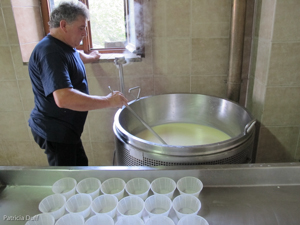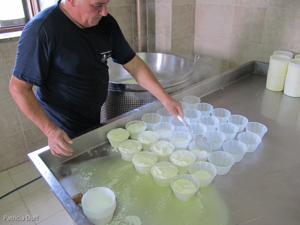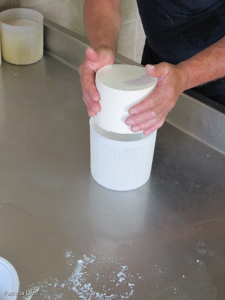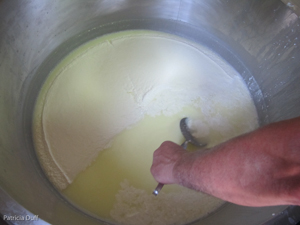|
|
|
|

|
||
|
|
|
|
| The gas is lit once again to reach a temperature of 90'. | ||
|
|
|
|

|
||
|
|
|
|
| While waiting for the temperature to be reached, Francesco turns the cheeses out of the sieves and replaces them, bottom up ... | ||
|
|
|
|

|
||
|
|
|
|
| ... placing one over another to add weight to assist in expelling the whey. | ||
|
|
|
|

|
||
|
|
|
|
| He checks the temperature and using a flat tool ... | ||
|
|
|
|

|
||
|
|
|
|
| ...strokes the bottom of the vat with flat scraper tool to assist the curds to rise. | ||
|
|
|
|

|
||
|
|
|
|
| In between scraping, Francesco swabs down the dairy floor. | ||
|
|
|
|

|
||
|
|
|
|
| The Ricotta continues to rise ... "Basta che c'e muovimento in giu," he explains. | ||
|
|
|
|

|
||
|
|
|
|
| Returning to the fresh pecorino, Francesco once more switched the lower cheese with the one on the top, tapping so the whey dripps out ... The cheeses had already shrunk. | ||
|
|
|
|

|
||
|
|
|
|
| He scrapes a little more, then removes, cleans and rinses the tool - hanging it up to dry. | ||
|
|
|
|

|
||
|
|
|
|
| He then rinses of a wooden spatula and carefull makes a cross on surface of the ricotta to section it into quarters. | ||
|
|
|
|

|
||
|
|
|
|
| Then with a flat metal ladel, he lifts the curds from the edge and fills the sieves, each one half full. | ||
|
|
|
|

|
||
|
|
|
|
| He takes the ricotta from the edge pf one quarter only before moving to the next ... | ||
|
|
|
|

|
||
|
|
|
|
| so each quarter remains undisturbed until lifted out. | ||
|
|
|
|

|
||
|
|
|
|
| This insures the ricotta remains as soft as possible. | ||
|
|
|
|

|
||
|
|
|
|
| Working smoothly, Francesco returns to the half full seives to fill them completely. | ||
|
|
|
|

|
||
|
|
|
|
| ...and loads in the back of his car ready for immediate transportation to a local agritourism. | ||
|
|
|
|

|
||
|
|
|
|
| The pecorino cheeses are removed from their sieves and turned one last time ... | ||
|
|
|
|

|
||
|
|
|
|
| ...and left in twos, the weight of one pressing on the top of the other. | ||
|
|
|
|

|
||
|
|
|
|
| The remaining whey is given to the dogs and pigs; but he reminisces that, in his youth, it was boiled up to leaves a wax which was made into candles. | ||
|
|
|
|

|
||
|
|
|
|
| In the evening, the cheeses are placed in a salt bath prepared with a kilo of rock salt to a litre of water. | ||
The photographs on this site are for the use of the Participants of the Event and their Families and Friends and may be copied and printed for personal use only. Their use for commercial purposes is governed by copyright and permission must be obtained from the webmaster . Events-On-Line ~ (C) 2013









